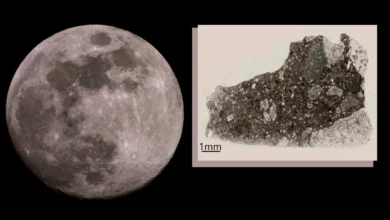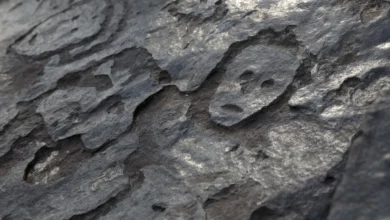
In a remarkable discovery, researchers have unearthed a 3D fragment of a rare unknown creature fossilized skin. It is roughly 286 million years old. Surpassing the age of any known skin fossils by at least 21 million years.
This ancient skin, which adorned an early Paleozoic reptile, boasts a distinctive pebbled texture. Bearing a striking resemblance to modern-day crocodile skin.
This discovery marks the oldest known example of epidermis preservation in terrestrial reptiles, birds, and mammals. It highlights the evolutionary significance of the outermost skin layer in adapting to life on land.
The fossilized skin, along with other specimens, was extracted from the Richards Spur limestone cave system in Oklahoma. A site renowned for its unique preservation conditions.
Ethan Mooney, a paleontology graduate student at the University of Toronto and the study’s first author, expressed his excitement.
“Now and then we get an exceptional opportunity to glimpse back into deep time,” said Mooney. “These discoveries can enrich our understanding and perception of these pioneering animals.”
Read Also: Ancient DNA Reveals How Ms-Risk Genes Arose
Fossilized skin is a rarity
The rarity of soft tissue fossilization makes this finding particularly significant. The researchers believe that combining fine clay sediments, oil seepage, and an oxygen-poor cave environment at Richards Spur played a pivotal role in preserving the skin.
“Animals would have fallen into this cave system during the early Permian. And been buried in very fine clay sediments that delayed the decay process,” Mooney elaborates.
“But the kicker is that this cave system was also an active oil seepage site during the Permian, and interactions between hydrocarbons in petroleum and tar are likely what allowed this skin to be preserved.”
Small size, big science
Despite its diminutive size—smaller than a fingernail—the fossilized skin revealed detailed epidermal tissues under microscopic examination by coauthor Tea Maho of the University of Toronto Mississauga.
These tissues are characteristic of amniotes, a group of terrestrial vertebrates that includes reptiles, birds, and mammals that evolved from amphibian ancestors during the Carboniferous Period.
“We were shocked by what we saw because it’s completely unlike anything we would have expected,” says Mooney.
“Finding such an old skin fossil is an exceptional opportunity to peer into the past and see what the skin of some of these earliest animals may have looked like.”
The prehistoric time capsule in this fossilized skin
The fossilized skin’s features included a pebbled surface akin to crocodile skin and hinged regions between scales reminiscent of snakes and worm lizards.
These distinct attributes suggest a resemblance to both ancient and current reptiles. However, the absence of associated skeletal remains leaves the exact species or body region of the skin unknown.
This similarity underscores the evolutionary importance of such skin structures for survival in terrestrial environments.
“The epidermis was a critical feature for vertebrate survival on land,” says Mooney. “It’s a crucial barrier between the internal body processes and the harsh outer environment.”
The team hypothesizes that this skin may represent the ancestral structure for terrestrial vertebrates in early amniotes, paving the way for the evolution of bird feathers and mammalian hair follicles.
Richards Spur cave system
Bill and Julie May, lifelong paleontology enthusiasts, collected the skin fossil and other specimens at Richards Spur.
The unique conditions at this limestone cave system in Oklahoma have preserved many of the oldest examples of early terrestrial animals.
These specimens are now housed at the Royal Ontario Museum, providing invaluable insights into the ancient world and its inhabitants.
In summary, this fossilized skin discovery offers a profound glimpse into the ancient world of terrestrial vertebrates.
Through passionate endeavor and meticulous study, scientists and paleontology enthusiasts contribute invaluable knowledge to our collective understanding of the rich tapestry of life that has inhabited our planet for millions of years.
The full study was published in the journal Current Biology.





